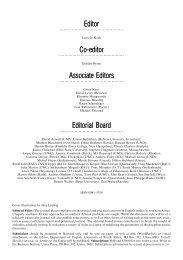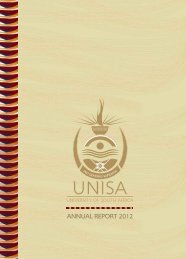Download the Annual report 2011 - Unisa
Download the Annual report 2011 - Unisa
Download the Annual report 2011 - Unisa
Create successful ePaper yourself
Turn your PDF publications into a flip-book with our unique Google optimized e-Paper software.
Financial risk management<br />
UNISA ANNUAL REPORT <strong>2011</strong><br />
The University’s principal financial instruments comprise <strong>the</strong> following: interest-bearing borrowings, financial assets at<br />
fair value through profit or loss (including equity instruments, debt instruments and unit trust investments) as well as<br />
cash and cash equivalents. The main purpose of <strong>the</strong>se financial instruments is to fund <strong>the</strong> University’s current and future<br />
operations. The University has o<strong>the</strong>r financial assets and liabilities such as student and o<strong>the</strong>r receivables and trade payables,<br />
which arise directly from its operations.<br />
The main risks arising from <strong>the</strong> University’s financial instruments are credit risk, market risk and liquidity risk<br />
The University’s financial risk management objectives and policies are governed by a formalised investment policy and<br />
related procedures approved by <strong>the</strong> Council of <strong>the</strong> University. The means by which <strong>the</strong> risks referred to above are managed<br />
include a specified strategic asset allocation between different categories of financial assets and <strong>the</strong> appointment<br />
of specialised investment managers. The investment managers are issued with specific mandates that include restrictions<br />
to manage <strong>the</strong> financial risks referred to above. The Operational Investment Committee monitors <strong>the</strong> investment<br />
performance on a regular basis.<br />
The University does not undertake any specific hedging activities.<br />
19.1 Credit risk<br />
Credit risk is <strong>the</strong> risk of financial loss to <strong>the</strong> University if a student, employee or counter party to a financial<br />
instrument fails to meet its contractual obligations, and arises principally from <strong>the</strong> University’s receivables from<br />
students, employees and investment securities.<br />
The University is exposed to credit risk arising from student receivables relating to outstanding fees. The<br />
University requires students to pay a minimum deposit on registration in respect of fees in order to mitigate<br />
this risk. Outstanding fees are monitored on a regular basis and action is taken in respect of long outstanding<br />
amounts. The University is also exposed to credit risk arising from unsecured vehicle loans made to employees.<br />
The University no longer grants loans.<br />
Credit risk also arises from <strong>the</strong> University’s o<strong>the</strong>r financial assets, which comprise cash and cash equivalents<br />
and financial assets at fair value through profit or loss. The University places cash and cash equivalents with<br />
reputable financial institutions and invests through specialised investment managers with mandates restricting<br />
credit risk exposure.<br />
19.1.1 Exposure to credit risk<br />
Impairment losses<br />
The ageing of student receivables at <strong>the</strong> <strong>report</strong>ing date was:<br />
Gross debtors<br />
impaired<br />
<strong>2011</strong> 2010<br />
Gross debtors<br />
not impaired<br />
| 107 |<br />
Gross debtors<br />
impaired<br />
Gross debtors<br />
not impaired<br />
R’000 R’000 R’000 R’000<br />
Past 120 days 74 779 36 890 38 058 39 397<br />
More than one year 0 0 0 0<br />
Total 74 779 36 890 38 058 39 397<br />
All debtors that are past 120 days are past due.<br />
The maximum exposure to credit risk for student receivables at <strong>the</strong> <strong>report</strong>ing date by geographic region was:

















